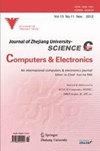Examination of the wavelet-based approach for measuring self-similarity of epileptic electroencephalogram data
Journal of Zhejiang University-Science C-Computers & Electronics
Pub Date : 2014-12-01
DOI:10.1631/jzus.C1400126
引用次数: 3
Abstract
Self-similarity or scale-invariance is a fascinating characteristic found in various signals including electroencephalogram (EEG) signals. A common measure used for characterizing self-similarity or scale-invariance is the spectral exponent. In this study, a computational method for estimating the spectral exponent based on wavelet transform was examined. A series of Daubechies wavelet bases with various numbers of vanishing moments were applied to analyze the self-similar characteristics of intracranial EEG data corresponding to different pathological states of the brain, i.e., ictal and interictal states, in patients with epilepsy. The computational results show that the spectral exponents of intracranial EEG signals obtained during epileptic seizure activity tend to be higher than those obtained during non-seizure periods. This suggests that the intracranial EEG signals obtained during epileptic seizure activity tend to be more self-similar than those obtained during non-seizure periods. The computational results obtained using the wavelet-based approach were validated by comparison with results obtained using the power spectrum method.基于小波的癫痫病脑电图数据自相似度测量方法研究
自相似或尺度不变性是包括脑电图(EEG)信号在内的各种信号的一个令人着迷的特征。用于表征自相似性或尺度不变性的常用度量是谱指数。本文研究了一种基于小波变换的谱指数估计方法。采用一系列具有不同消失矩数的Daubechies小波基,分析癫痫患者不同脑病理状态(即发作期和间歇期)所对应的颅内脑电图数据的自相似特征。计算结果表明,癫痫发作时脑电信号的谱指数往往高于非发作时的谱指数。这表明在癫痫发作活动期间获得的颅内脑电图信号比在非癫痫发作期间获得的信号更具有自相似性。通过与功率谱法计算结果的比较,验证了小波法计算结果的正确性。
本文章由计算机程序翻译,如有差异,请以英文原文为准。
求助全文
约1分钟内获得全文
求助全文
来源期刊
自引率
0.00%
发文量
0
审稿时长
2.66667 months

 求助内容:
求助内容: 应助结果提醒方式:
应助结果提醒方式:


